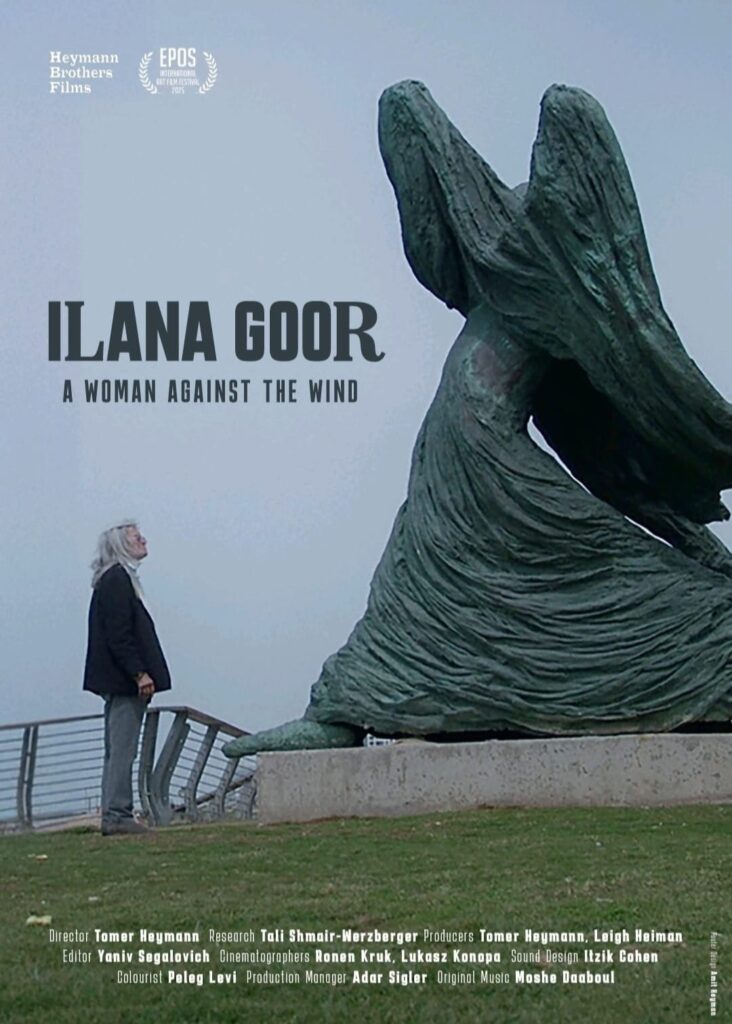
The power of the new documentary Ilana Goor – A Woman Against the Wind lies within its authenticity. The incredible story of the Israeli artist/designer and her rise from childhood in pre-state Israel on the shore of the Sea of Galilee to Manhattan’s design world is captured by the fantastic cinematography of filmmaker Tomer Heymann. The exceptional chemistry between the two of them forms the core of this film as the power and influence of the director is hardly noticeable as he allows her energy to speak for itself. “She does not take herself too seriously,” he told me about the reason. He immediately recognized her ability to be true to her values and her genuine expression of her inner self. In fact, it was when Heymann began his research that he realized that many of her sculptures in public spaces were favorites of his without him even knowing that they were hers.
The film follows the story of the Israeli artist/designer Ilana Goor as told by her, vividly interwoven with the story of Israeli statehood—the place that stands at the core of her identity. Her life path has been an expression of the collective identity and narrative of the evolution of Israel. Watching the film helps us recognize that when you don’t plan, things are still going to come to you because life is filled with surprises. Turning a new leaf one after the other presents us with the opportunity to change and grow. Goor never planned her career, nor her life journey, but one thing led to another, and she eventually formed a global career. She is certainly an artist of another type. Not only does she not belong to any movement or school, but she has always been a loner that does things in her own way. The film emphasizes that aspect of her personality: her work, the way she collects, and the extraordinary life that she crafted with her own hands. In fact, her work is so authentic and spontaneous that it is only fully revealed when told by her.
The dark glasses, the big hair, the leather pants, and enormous gold jewelry have become her trademarks. They make her look strong, distant, skeptical—or perhaps critical—but Goor’s looks are deceiving. Her personality is fully on display in the documentary. Heymann says that while she is assertive, bold, and confident, there is also a side of her that is warm, sensitive, caring, and unpretentious, traits he successfully captures.
Born in 1936, Goor’s mother was Israel’s first woman gynecologist. She spent the first ten years in Tiberias, the ancient town on the western shore of the Sea of Galilee in northern Israel. But when her mother became ill, everything changed, and she was sent to a kibbutz along with her older brother, the late heart surgeon Dani Goor, and never saw her mother again. It is that fundamental sense of being left alone in this world that has come to not only guide her but also formed the core of her art. There is nothing heartachingly painful to her being alone, as this is the foundation of her identity, vision, and way of life.
Now, at 89 years old, she lives the way she wants to. Her work is biographical, presenting the narratives close to her heart in the most direct and honest way, and her art collection is a collage of her own voice and taste. The collection as a whole, she says, has value because it is a reflection of her own. After her death, it will be sold and the funds will be donated to help the vulnerable, children, and animals.
The documentary guides us through the benchmarks in the journey of Goor’s life, illustrated with historic footage which enriches the film. From Tiberias to Jerusalem where she went to school and met her husband Lenny Lowengrub seven decades ago to New York, her beloved city, and the years in Los Angeles where she, a young mother, took a ceramics class that led to a monumental career.
The film brings us into her New York home, a former carriage house that she turned into a showcase of her vision and collections, and to her home in Jaffa, an incredibly ambitious achievement that is a museum open to the public. It was originally built in the 18th century as a hostel for pilgrims arriving at the Holy Land through the local port. She has turned this enormous stone structure, perhaps Israel’s most beautiful house, into her own personal museum where art, design, architecture, and lifestyle are merged in unexpected ways. The building is indigenous and beautifully restored, utilized as the backdrop for her own art and for her collections that include sculptures by Henry Moore, lamps by Ingo Maurer, paintings by Anselm Kiefer, and thousands of pieces selected one by one and brought from Namibia to Poland, from Turkey to Italy, and every corner on earth.
I met Goor decades ago when I gave lectures on design history at her museum, and our friendship grew over time as I was able to get to know the real woman behind the persona. Despite my personal acquaintance, I still learned a lot from the film. She named her second son after Ashley Wilkes, the fictional character in Margaret Mitchell’s 1936 novel Gone with the Wind, which was published the year she was born. The famed Scarlett O’Hara line, “After all, tomorrow is another day,” became her mantra. Like her, every day is refreshing and encouraging, bringing new opportunities and new energies. I don’t know anyone who has mastered the art of turning pages like her.

